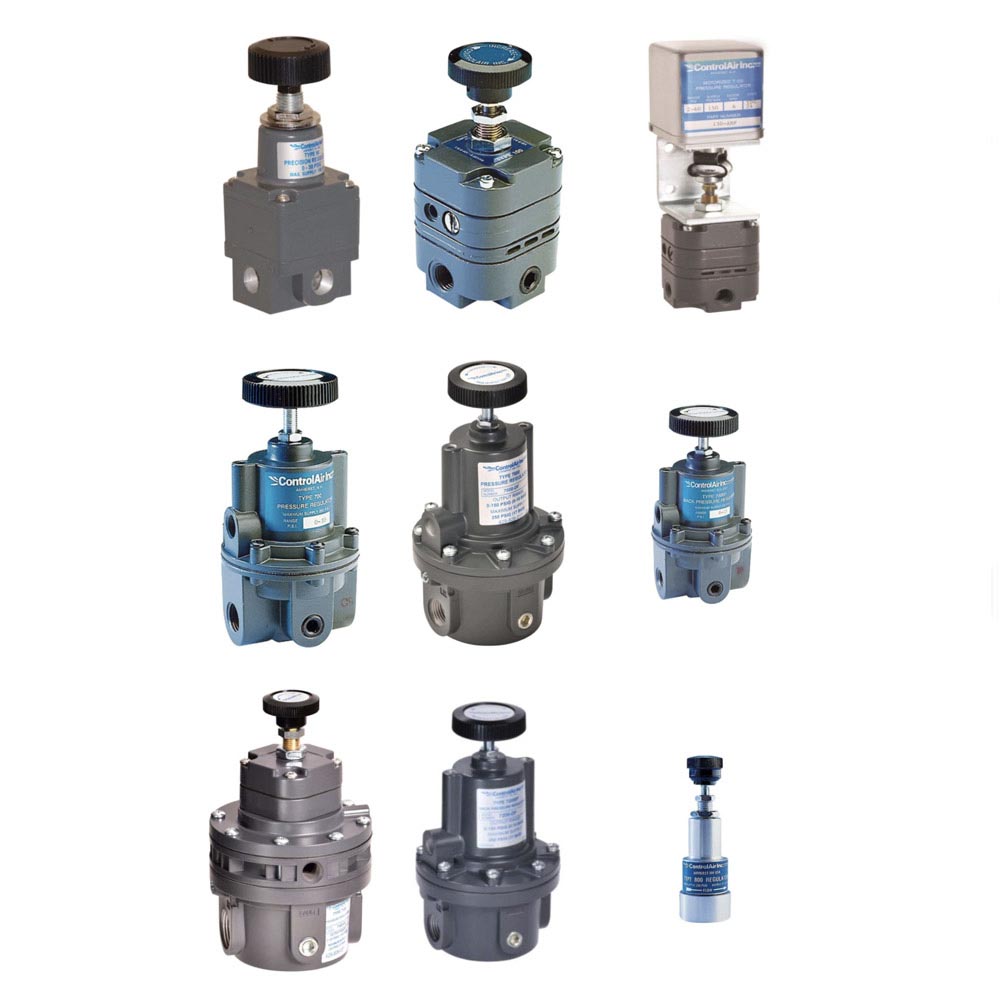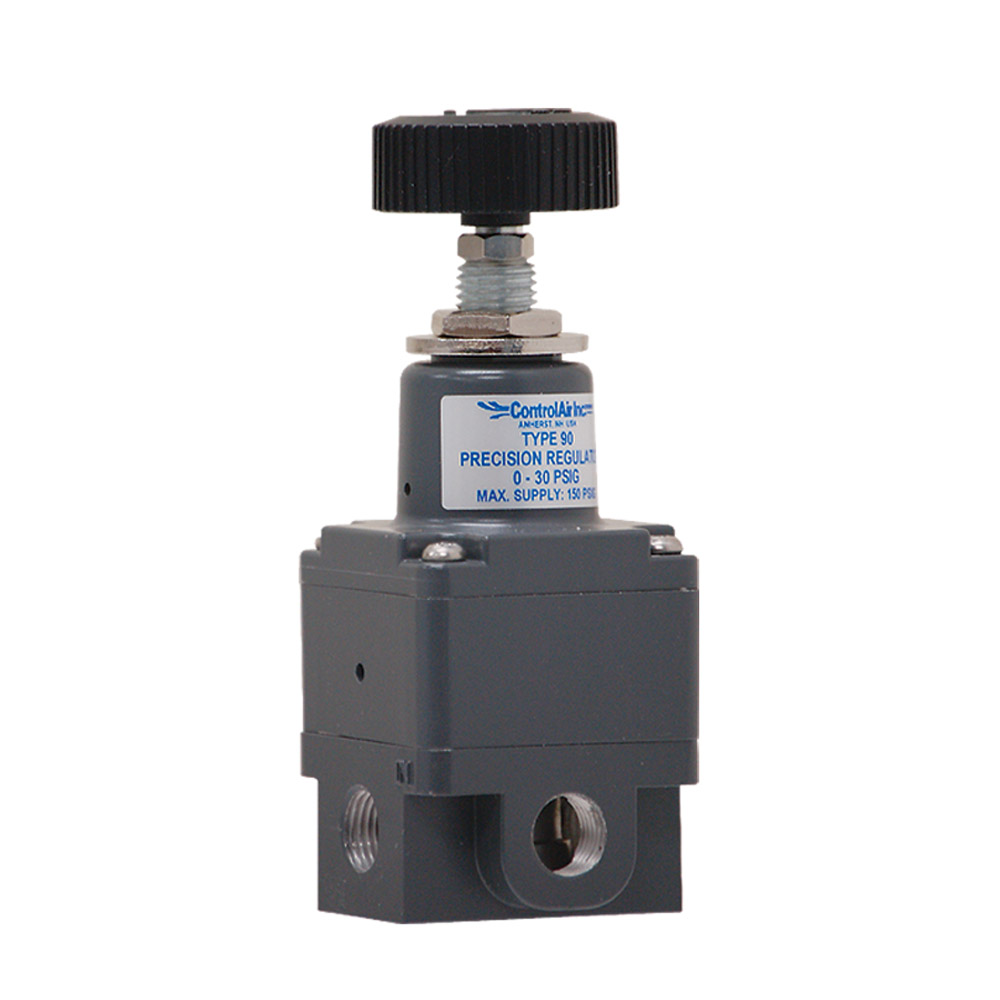
Designed specifically for the OEM market, these units are ideal for compressed air or water pressure control applications. The ControlAir Type-850 and Type-860 are compact units that provide low-cost, high performance pressure regulation of compressed air (Type 850 and Type 860) or water (Type 860). Type 850/860 Miniature General Purpose Regulator Corrosion resistant materials, lightweight construction and low cost, combine to make the Type 800 ideal for any application where space is at a premium. The Type 800 is also available with a variety of convenient port sizes and mounting options. An oversized supply valve provides the Type 800 with significantly higher flow capacities than competitive units of similar size. This high quality unit, available in five pressure ranges up to 100 psig (7 BAR), offers the same dependable performance as ControlAir's larger precision air pressure regulators.

The Type-800 is a compact air regulator that supplies precise air pressure control for applications where space is limited. Type 800 Subminiature Precision Pressure Regulator Stability of regulated pressure is maintained under varying flow conditions through the use of an aspirator tube which adjusts the air supply in accordance with the flow velocity. A poppet valve which is balanced by utilizing a rolling diaphragm insures a constant output pressure even during wide supply pressure variations. The Type 700 is designed for applications that require high flow capacity and accurate process control. Durable materials and corrosion resistant construction provide reliable operation in harsh industrial environments. The regulation characteristics of the Type 400 have been proven to be superior to comparable competitive units. This quality unit is ideal as an economical alternative for control of industrial process applications. The Control Air Type 400 is a general purpose regulator designed to provide reliable performance under variable operating conditions. A stainless steel measuring capsule is used as a sensing element to activate the high gain servo balanced control mechanism in which the main valve is controlled by a pilot valve.This allows for greater accuracy and eliminates many of the problems associated with conventional regulators using range springs and diaphragms. The Type-100 is ideal for applications that call for the utmost of control and maximum stability under variable operating conditions. This pressure controller provides the highest level of regulation accuracy and repeatability available. The Type-100 is a high precision, multi-stage pressure regulator. You can also see the resumption of fuel flow as a slight blip in the tach.Type 100 Precision Air Pressure Regulator If you pay attention, you can feel the fuel cutoff, and then the sudden resumption of fuel flow as the vehicle coasts through ~25 MPH.

The fuel cutoff can easily be seen if you have any means of displaying instantaneous fuel consumption. Under conditions of rapid throttle cut, the ECM completely cuts off ALL fuel flow, and resumes fuel flow only when vehicle speed drops to ~25 MPH. In particular, "Backing off the pedal quickly in the FJ will cause higher fuel use because the ECU uses the engine to help slow it down ( auto trans only)" is totally incorrect.Ĭertainly the ECM uses engine braking to help slow the vehicle under closed throttle conditions, but in no way does that increase fuel usage.
CONTROLAIR 13825 FULL
Anything that will reduce the volume of air flowing through the engine will reduce fuel consumption.įull throttle volumetric efficiency may be at its peak at a higher RPM, but we are not talking about constant speed, full-throttle, full load operating conditions like may be experience with an IC engine driving a pump or generator. Keeping the engine's fuel-feedback and ignition systems in perfect condition.Ĭlick to expand.I don't believe that any of this is correct, from the standpoint of fuel burn rate.

No $39 programmer is going to measurably improve fuel economy without leaning out the mixture to the point where engine damage is possible. Toyota took every possible action to maximize fuel economy on the FJ (low-viscosity, low drag lubricants, extremely conservative transmission shift programming, dual VVTi variable cam timing, etc., etc.). What is the "spec point"? Window sticker EPA fuel economy numbers? These sensors have a useful life of 85 - 100K miles, so if you are still running on the original sensors, they are almost certainly degraded and not providing accurate information to the engine ECM. Have you also replaced the two Fuel-Air sensors (front sensors in the exhaust system)? These two sensors, in conjunction with the MAF sensor, control air-fuel ratio. When you say 'replaced map sensor', do you mean the MAF (Mass Air Flow) sensor, and was it an OEM Toyota (Denso) sensor?Ĥ.


 0 kommentar(er)
0 kommentar(er)
